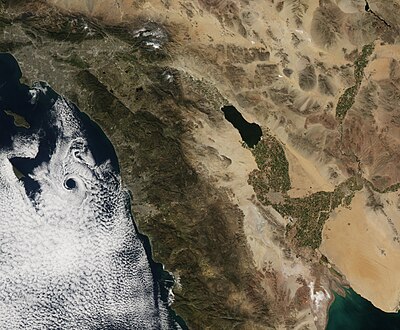| Imperial Valley Geothermal Project | |
|---|---|
 The J.M. Leathers Geothermal Power Station | |
 | |
| Official name | Imperial Valley Geothermal Project |
| Country | United States |
| Location | Near Calipatria Imperial County, California |
| Coordinates | 33°09′48″N 115°37′00″W / 33.16333°N 115.61667°W |
| Status | Operational |
| Commission date | 1982 |
| Owner | CalEnergy(86.4%) EnergySource (13.6%) |
| Operator | CalEnergy |
| Geothermal power station | |
| Type | Dry steam |
| Power generation | |
| Units operational | 14 units (11 power stations) |
| Units planned | 1 unit |
| Nameplate capacity | 432.3 MW[1] |
| Annual net output | 1,741 GWh (2018) [1] |
| External links | |
| Commons | Related media on Commons |
Imperial Valley Geothermal Project is a complex of eleven geothermal power stations located in the Salton Sea Geothermal Field, along the southeastern shore of the Salton Sea in the Imperial Valley of California. It is the second largest geothermal field[clarification needed] in the United States after The Geysers in Northern California.[citation needed]
Description
[edit]Parts of Imperial Valley lie atop the Salton Sea Geothermal Field, a region of high geothermal energy with an estimated 2,950 MW of geothermal potential. Of that total, 2250 MW are currently developable, while the remaining 700 MW would become available as the Salton Sea (a saline lake) dries up.[2] About 403 MW is generated by the existing power plants, ten of which are owned by CalEnergy and one by EnergySource.[3]
Geothermal power and lithium extraction
[edit]The geothermal activity below the Salton Sea loosens up lithium that can be mined.[4] The California Energy Commission estimates the Salton Sea might produce 600k metric tons of lithium carbonate (Li
2CO
3) per year,[5] of a reserve of 3.4 million tonnes.[6]
In 2016, the Australian firm Controlled Thermal Resources (CTR) announced plans to build a 140 MW geothermal power plant and a lithium extraction facility capable of producing 15,000 tons (13,600 tonnes) by 2023 and 75,000 tons (68,000 tonnes) by 2027. The company hopes to create a major new domestic source of the mineral, which is a key ingredient used in batteries for electric cars and energy storage. The project is expected to be operational by 2023.[7][8] General Motors announced a strategic partnership with CTR in 2021 to secure a local supply of lithium. The majority of the battery-grade lithium hydroxide and carbonate for the Ultium battery will come from this plant.[9]
Geothermal power stations
[edit]This is a table of all constituent geothermal power stations.[2][1]
| Name | Units | Type | Status | Capacity (MW) |
Owner | Commissioned |
|---|---|---|---|---|---|---|
| A.W. Hoch | 1 | Dry steam | Operational | 45.5 | CalEnergy | 1989 |
| CE Turbo | 1 | Dry steam | Operational | 11.5 | CalEnergy | 2000 |
| Hell's Kitchen | ? | Dry steam | Planned | 140 | CT Resources | (2025) |
| J.J. Elmore | 1 | Dry steam | Operational | 45.5 | CalEnergy | 1989 |
| J.L. Featherstone | 1 | Dry steam | Operational | 55 | EnergySource | March 2012 |
| J.M. Leathers | 1 | Dry steam | Operational | 45.5 | CalEnergy | 1990 |
| Salton Sea 1 | 1 | Dry steam | Operational | 10 | CalEnergy | 1982 |
| Salton Sea 2 | 3 | Dry steam | Operational | 20 | CalEnergy | 1990 |
| Salton Sea 3 | 1 | Dry steam | Operational | 54 | CalEnergy | 1989 |
| Salton Sea 4 | 1 | Dry steam | Operational | 47.5 | CalEnergy | 1996 |
| Salton Sea 5 | 1 | Dry steam | Operational | 58.3 | CalEnergy | 2000 |
| Vulcan | 2 | Dry steam | Operational | 39.6 | CalEnergy | 1985 |
| J.G. McIntosh | 1 | Closed loop | Abandoned[10] | 20 | GeoGenCo | — |
See also
[edit]References
[edit]- ^ a b c "Electricity Data Browser - Salton Sea Complex (11 plants)". www.eia.gov. Retrieved February 6, 2020.
- ^ a b "The Shrinking Salton Sea and its Impact on Geothermal Development" (PDF). geothermal.org. 2017. Archived from the original (PDF) on February 6, 2020. Retrieved February 6, 2020.
- ^ "EnergySource's First Geothermal Plant in Imperial Valley Lauded for Creating Jobs, Boosting the Economy, Delivering Clean Energy to 50,000 Homes; Second Plant to Follow". www.businesswire.com. May 18, 2012. Retrieved February 7, 2020.
- ^ Fernández, Caleb J. (August 31, 2021). "Lithium fuels hope for Salton Sea". KYMA. Associated Press. Retrieved September 4, 2021.
- ^ Alistair MacDonald and Jim Carlton. (February 8, 2022). "Where Is There More Lithium to Power Cars and Phones? Beneath a California Lake.". Wall Street Journal Retrieved February 9, 2022.
- ^ Ferry, Tim (November 29, 2023). "'Once in a generation' | US confirms huge lithium deposits in California's Salton Sea". Recharge | Latest renewable energy news.
- ^ "Lithium will fuel the clean energy boom. This company may have a breakthrough". Los Angeles Times. October 14, 2019. Retrieved February 7, 2020.
- ^ "California needs clean energy after sundown. Is the answer under our feet?". Los Angeles Times. January 22, 2020. Retrieved February 7, 2020.
- ^ Cohen, Ariel (July 26, 2021). "General Motors Moves To Secure Its Own Critical Mineral Supply Chains". Forbes. Retrieved July 28, 2021.
- ^ "Order to Plug and Abandon Wells, Pay Assessment Fees, and Pay Civil Penalties" (PDF). California Department of Conservation. June 4, 2024. Retrieved August 14, 2024.

